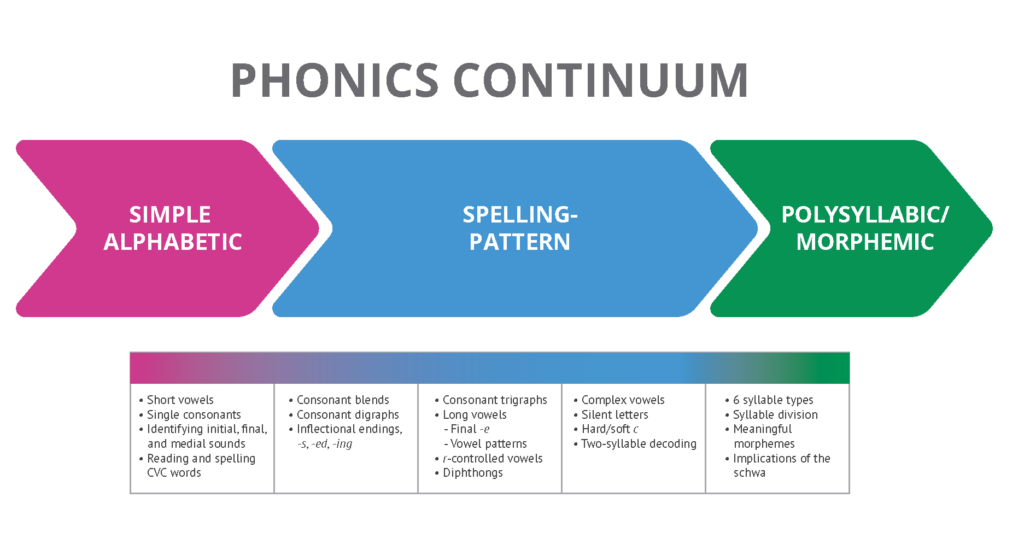In recent years, a big focus in reading instruction has been explicitly teaching foundational skills to close the gap for our neediest readers. Schools are digging deep into data and research and working hard to help students master the K–1 foundational skills standards.
A common assumption is that this praiseworthy effort will be enough to successfully accelerate these readers. However, student data frequently shows these same students still lag behind in reading comprehension. Teachers are asking, “What do I do?”
What exactly is impeding comprehension?
In a recent data dive I completed with a partner district, we looked at a group of third graders. These students were presenting as one grade level behind in phonics and two grade levels behind in comprehension on the Universal screener.
One of the skills the screener recommended we target for these students was to teach decoding of two-syllable words. Specifically,
- words with long vowels (including those with open syllables),
- vowel pair syllables, and
- CVCe syllables.
Another area of focus the screener recommended was teaching meaningful word parts. Students can greatly expand their vocabulary by learning how prefixes and suffixes change the meaning of base words and root words. Specifically,
- teach or review the meanings of these prefixes: pre-, un- and re-,
- teach or review the meanings of these suffixes: -ful, and -less, and
- provide instruction and practice in identifying base words.
When I asked the question, “What does this group of students need to focus on next?” a majority of educators recommended that these third graders be moved out of a phonics-based Tier 2 intervention group, and instead the focus shifted to comprehension.
One reading interventionist, however, pushed back. She agreed about the importance of comprehension, but also asked, “What exactly is impeding comprehension? Is it that the student doesn’t understand the story? Or is it that the student can’t decode/read the longer words to make meaning?”
While reflecting on these questions, one of the third-grade teachers brought up the fact that when her students encounter a multisyllabic word, most of the time they skip it.
These great questions and reflections shifted our conversation. The focus of our discussion moved from solely teaching comprehension strategies to explicitly teaching students how to decode multisyllabic words and those meaningful word parts that the students encounter in their third grade text.
This conversation also led us to look at the Phonics Continuum.
In Praise of the Polysyllabic/Morphemic Stage
As you can see below, there are three stages in the Phonics Continuum, the simple alphabetic stage, the spelling pattern stage and the polysyllabic/morphemic stage. These three stages are in service to comprehension.

When students’ texts become more demanding, the polysyllabic/morphemic stage is something of an overlooked or even lost treasure as we consider instruction. It is so important that we don’t skip over this stage, even when our students are in the upper elementary grades.
“We need phonics and other word analysis skills in order to get words into our heads” (T. Rasinski, 2018). Students must be able to read polysyllabic words fluently in order for them to access complex texts.
In the 2019 ILA Literacy Leadership Brief “Meeting the Challenges of Early Literacy Phonics
Instruction,” the section “Common Causes of Phonics Instructional Failure” notes that we often transition to multisyllabic words too late:
“Most curricula focus on monosyllabic words in grade 2, yet the stories students read at that grade are filled with more challenging, multisyllabic words. More emphasis needs to be given to transitioning to longer words at this grade (e.g., going from known to new words like can/candle and teaching the six major syllable types). This work can begin at the end of grade 1 to provide a closer alignment between phonics instruction and reading demands.”
As educators we often get to this vital stage too late—and with some struggling students, not at all.
Practical Considerations for Instruction
The word analysis skills teachers need to consider as students are transitioning out of the spelling pattern stage and into the polysyllabic/morphemic stage are:
- dividing two syllable words,
- learning open and closed syllables,
- dividing words between syllables,
- learning prefixes and suffixes,
- morphemic transformations, and
- learning Greek and Latin roots (etymology).
When we pair these word analysis skills with vocabulary and knowledge building, we are wrapping the strands of Scarbourgh’s Rope tighter and moving toward skilled reading—which leads to our ultimate goal of independent readers.
Teachers and interventionists need to be sure they are attending to this stage in instruction. How can we do that?
Tier 1 Instruction
In Tier 1 instruction, we must include a word study component in the ELA block. An example of work that could be done at this time would include (taken from Being a ReaderTM, Second Edition)
Tier 2 Instruction
Ensure that you are using an intervention program that does not stop after the spelling pattern stage. Challenge Level SIPPS® is a good example of this instruction that meets the students at their point of need. See example below.
Tier 3 Instruction
Tier 3 instruction involves adding some multisensory components into this polysyllabic/morphemic stage of instruction. See example below.
When we consider the complex and challenging words that readers in grades 2 and up encounter, it’s clear that we must not lose sight of the polysyllabic/morphemic stage. We must align our instruction accordingly. Rediscovering this lost treasure can open a whole new world of reading for our students.
